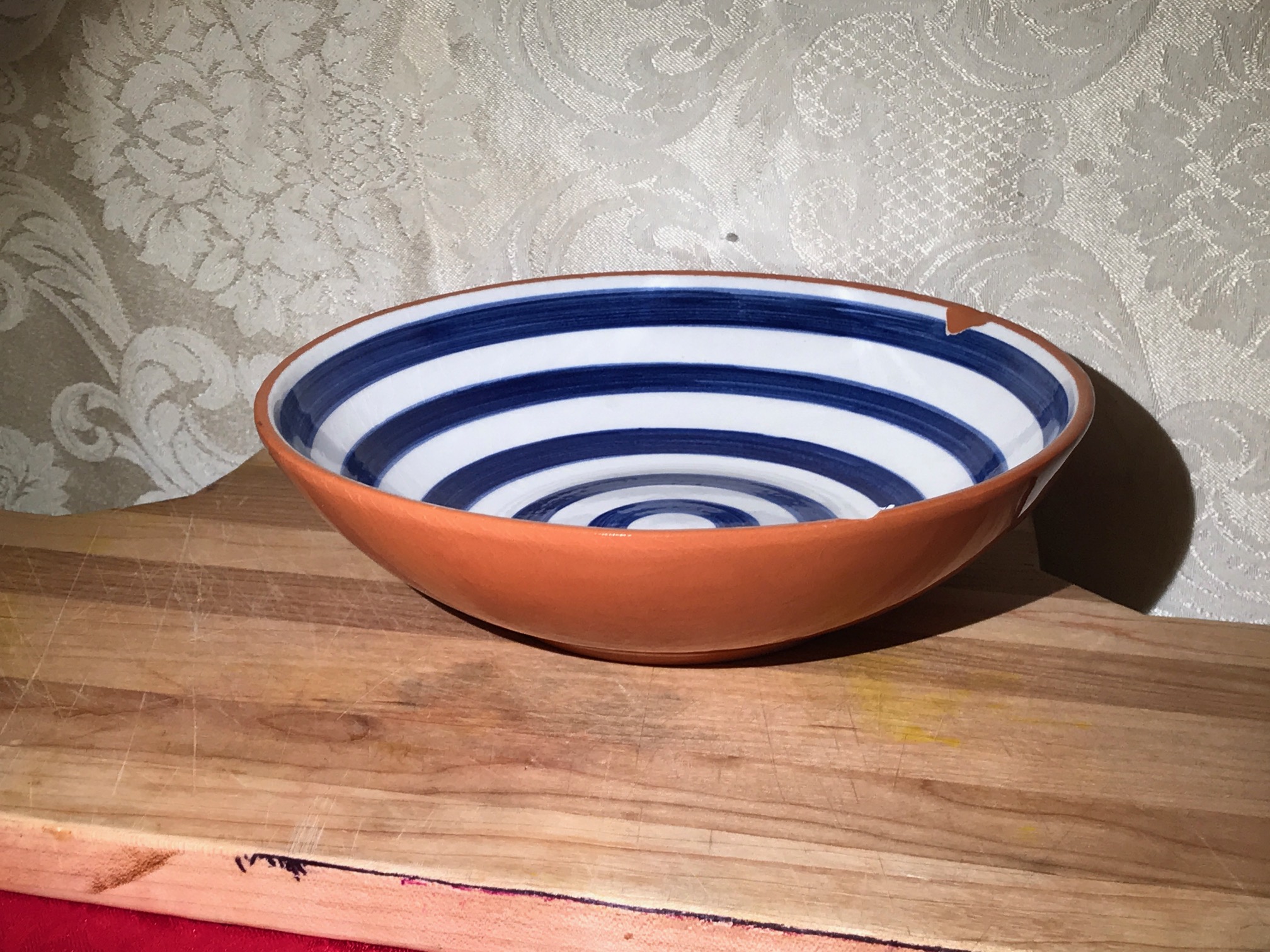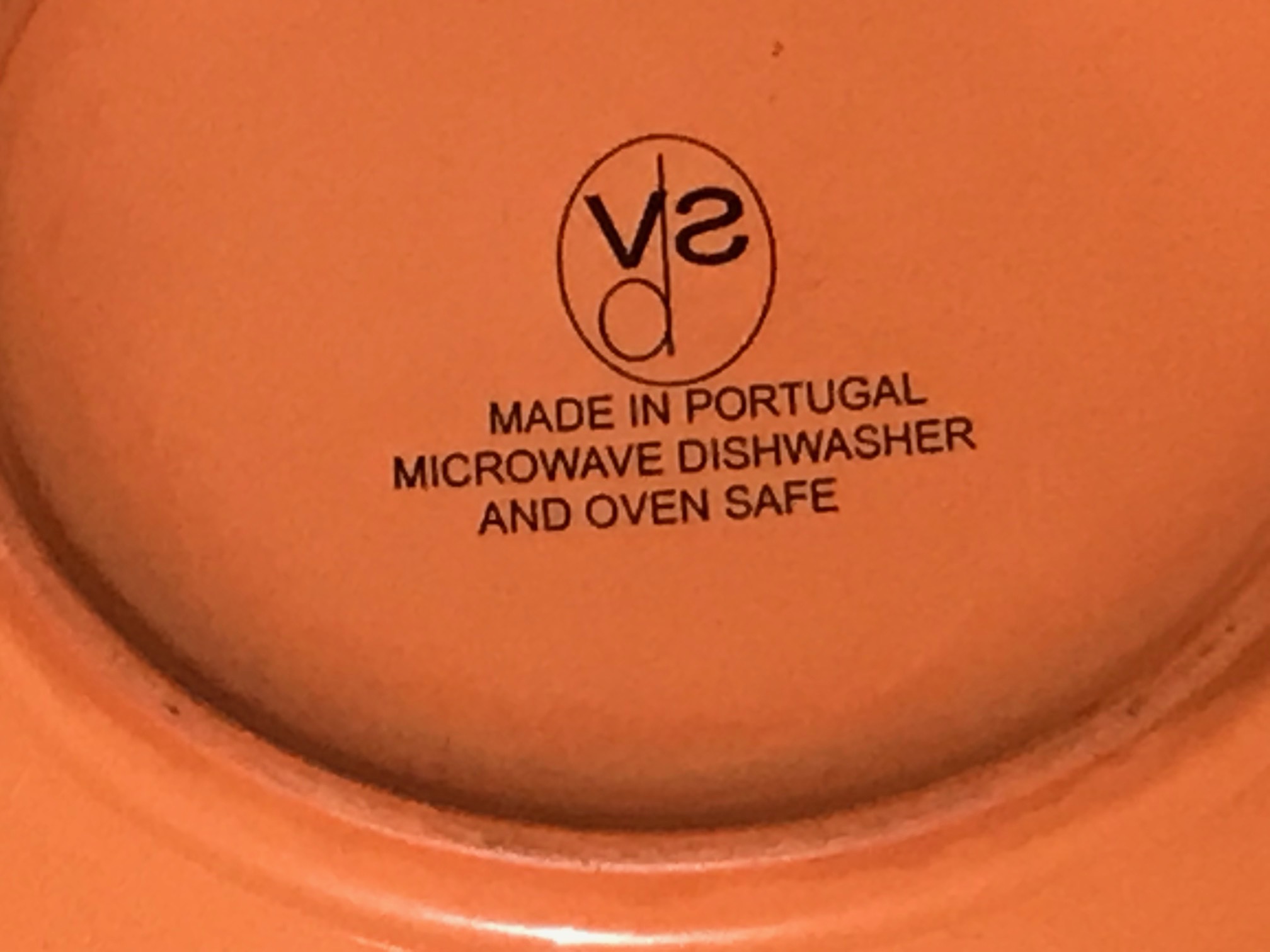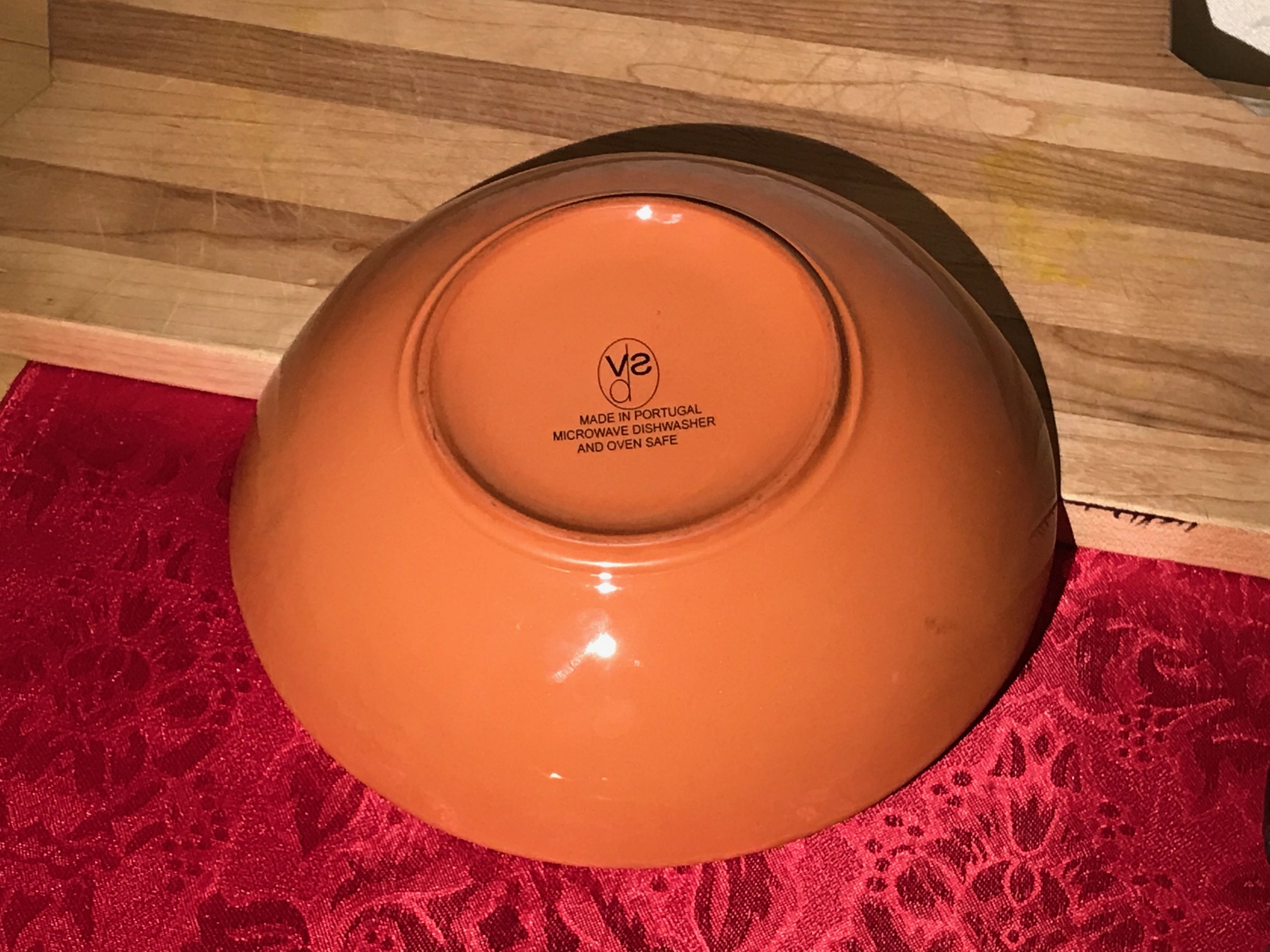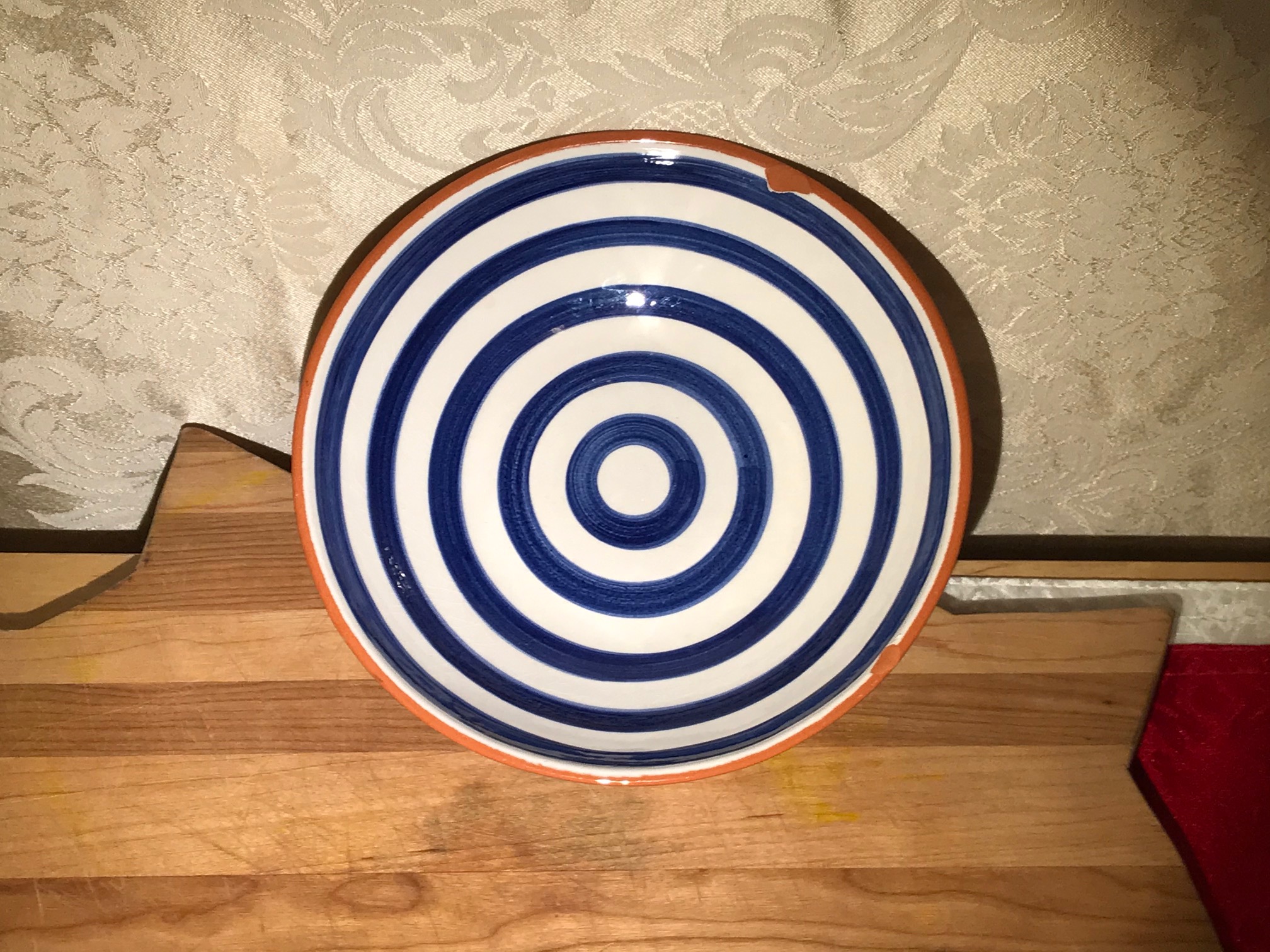vds “Made in Portugal” glazed bowl (suspected of causing an Elevated Blood Lead Level [EBL] in owner): 63,700 ppm Lead.
 One of my readers sent this dish to me because she tested positive for Lead – and was concerned that perhaps her dishes might be the source of her Lead exposure. Well… based on the XRF test results, it appears that in this case, her concerns are likely valid. When tested with a a high-precision XRF instrument, the bowl pictured here had the following readings:
One of my readers sent this dish to me because she tested positive for Lead – and was concerned that perhaps her dishes might be the source of her Lead exposure. Well… based on the XRF test results, it appears that in this case, her concerns are likely valid. When tested with a a high-precision XRF instrument, the bowl pictured here had the following readings:
Blue & White Center of Bowl (food surface):
- Lead (Pb): 63,700 +/- 1,900 ppm
- Barium (Ba): 1,840 +/- 150 ppm
- Zinc (Zn): 3,722 +/- 179 ppm
- Iron (Fe): 583 +/- 176 ppm
- Vanadium (V): 752 +/- 83 ppm
- Titanium (Ti): 1,850 +/- 157 ppm
Clear Glazed Terracotta (exterior surface):
- Lead (Pb): 46,800 +/- 1,300 ppm
- Barium (Ba): 1,547 +/- 128 ppm
- Zinc (Zn): 3,319 +/- 167 ppm
- Iron (Fe): 2,088 +/- 260 ppm
- Vanadium (V): 726 +/- 71 ppm
- Titanium (Ti): 1,628 +/- 130 ppm
XRF testing was done for a minimum of 60 seconds per component, and repeated multiple times to confirm the results. Results are science-based, accurate, and replicable.
How much Lead is “too much” Lead?
The amount of Lead that is considered unsafe – and illegal – in a modern / newly-manufactured item made and sold for use by children today is anything 90 ppm Lead or higher in the paint / glaze or coating, and anything 100 ppm Lead or higher in the substrate. Ceramic dishes are not covered by this regulatory standard (even though it is my opinion that they should be — because children obviously use dishes!)
If this bowl was manufactured today with these levels and (explicitly) sold as “intended for use by children” it would definitely be considered both unsafe and illegal. If it were manufactured today and sold for use by adults (i.e. not explicitly marketed as “intended for use by children“), it would be considered perfectly safe and legal (as long as it met regulatory limits for leach testing of Lead – at the time of manufacture)!
Takeaway:
I always recommend avoiding ANY food-use ceramics from Portugal. Nearly every single piece of ceramics from Portugal that I have tested has been positive for a very high level of Lead. To see more pieces I have tested that were marked as. “Made in Portugal”, click here.
As always, thank you for reading and for sharing my posts.
Please let me know if you have any questions.
Tamara Rubin
#LeadSafeMama


Never Miss an Important Article Again!
Join our Email List




I purchased my dishes from WM Sonoma about 1996(?) Block Spal Portugal Porto White Shape By Gerald Gulotta. This is freaking me out!!! How can I test them…where can I get a kit to test these and my others?
You really cannot test these yourself at home. If they are WM Sonoma from 1996 and Made in Portugal I would stop using the dishes and consider getting a blood Lead test (or a urine test) for yourself for Lead and other metals. WM Sonoma is a highly unethical company when it comes to selling lead contaminated products.
This piece discusses blood lead testing:
https://tamararubin.com/2019/02/blood-lead-testing-please-get-everyone-in-the-family-tested-since-you-have-been-living-in-a-house-with-high-lead-paint/
This piece discusses urine testing:
https://tamararubin.com/2020/05/i-heard-that-urine-and-hair-tests-for-heavy-metals-including-lead-were-not-real-or-useful-test-results-why-is-this/
Here’s the website menu too – with lots of quick link buttons for different topics: https://tamararubin.com/website-menu/
Tamara
Hello Tamara.
I tried reaching you through Fb but didn’t see an option to message you so am trying the email on your site. I’m hoping you can lend some expertise to help calm my extremely worried mind.
Bit of a pickle situation:
I have some bowls that I put through the dishwasher at regular cycle…a friend of mine put a decorative “made in Portugal“ Terracotta container in amongst it. It looks intact, but it was some hand me down she’s had for years from who knows where.
I said my concern was that especially with the heat this could very well leach chemicals (one being lead) onto the other bowls, dishes and washer itself.
She suggested we take that one piece out and discard it, and just run another soapy cycle.
My question is, would this be redundant?
Because now there lead that’s possibly been not only transferred but possibly baked on to these dishes and what ever else was in the dish washer (drinking glasses and such?)
Is the whole dishwasher contaminated?
Aye me.
I’m so scared everything is now contaminated. Even the fact that I took a breath when opening the washer, I feel may have exposed me to lead.
This is too much for me but I can’t bear to feel we may be poisoning ourselves by using these. I’m happy to get rid of them if that is the case.
Any suggestions and advice would be so welcome.
My immense gratitude for your expertise and advisement.
So Fearfully,
Jo
I just bought a set of Secla “Portugal” dishes at a yard sale. After being in the dishwasher the finish almost felt a little sticky. I noticed that heating a cup of coffee in one of the cups in the microwave that not only did the cup get extremely hot, but had a toxic smell. I poured the coffee in another cup (same) and it didn’t have the smell. Now I don’t trust any of the dishes; microwaved, dishwasher or hand wash. Unfortunately I’ll be getting rid of them, and don’t want to donate them anywhere and poison someone else. They were very pretty and not cheap, but not worth it. I had a feeling that smell might have contained lead.